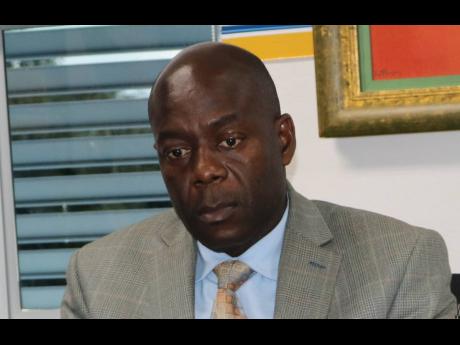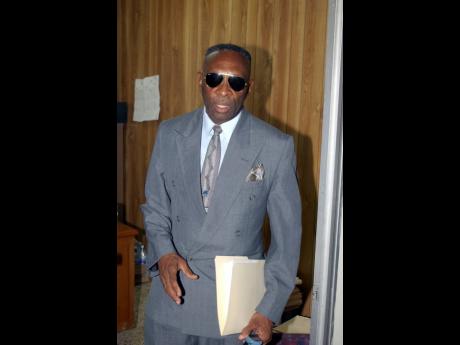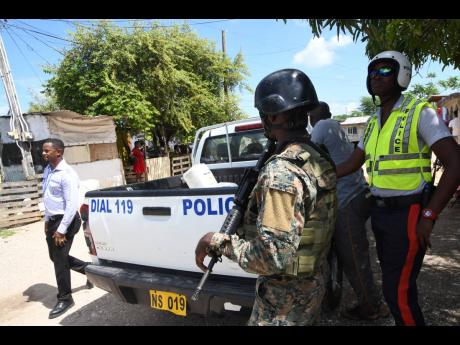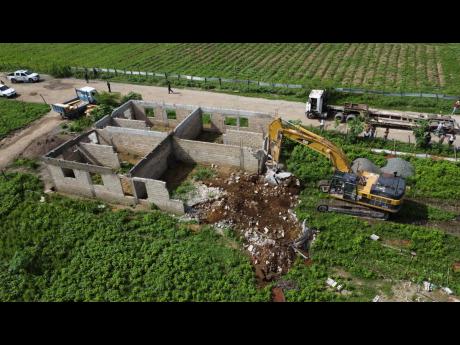Dismantling the gang culture
Law enforcement working to break the back of the criminal enterprises considered a threat to national security
Organised criminality continues to spread across Jamaica, as the gang culture extends its tentacles far and wide, even as law enforcement has been at pains to keep it under control. Last week’s much-publicised land scam in Clifton, St Catherine is...
Organised criminality continues to spread across Jamaica, as the gang culture extends its tentacles far and wide, even as law enforcement has been at pains to keep it under control. Last week's much-publicised land scam in Clifton, St Catherine is just one of the various means gangs use to fund their criminal enterprise, as they wreak mayhem across the island.
Jamaica has recorded 1,226 murders up to October 14, and “gangs are responsible for seven out of the 10 murders committed across the country,” said Assistant Commissioner of Police (ACP) Anthony McLaughlin, head of Counter-Terrorism and Organised Crime (C-TOC).
Except for 2003, Jamaica has passed the 1,000 homicide mark every year for the past two decades and remains the most murderous nation in Latin America and the Caribbean.
For the second consecutive year, Insight Crime ranked Jamaica as having the highest murder rate in Latin America and the Caribbean in 2021, with 1,463 homicides translating to 49.4 per 100,000 people – an increase from the 46.5 per 100,000 for 2020, when 1,301 homicides were recorded.
Jamaica Constabulary Force (JCF) data reveal that last year, 85 per cent of the 1,463 murders were committed with a gun, while 72 per cent were gang-related. At the same time, 80 per cent of the 765 robberies involved the use of a firearm. There were 1,258 shooting incidents for the year.
According to McLaughlin, Jamaica is battling the impact of first- and second-generation gangs on the crime crisis. There are three types of gangs, he said, characterized by their ability to organize and influence the authorities. Haiti is being plagued by a third-generation gang.
Jamaica now has approximately 240 gangs – some 190 first-generation and just over 50 second-generation – right across the island, with the major concentration of gang activity in Kingston and St Andrew, St James and St Catherine. But McLaughlin would not divulge the parish-by-parish distribution of the criminal outfits operating locally.
This is down from the over 250 that were in operation last year, as the security forces have stepped up collaborative efforts to dismantle them.
“What you are now seeing are a splintering of major gangs into smaller groups scattered across the island, while some are dormant,” McLaughlin said.
But some social commentators believe it to be a daunting task, as recurring economic crises and social inequality, characterized by high unemployment rates and the lack of basic infrastructure inherited from colonial times have given rise to many garrison communities, where gangsters enjoy loyalty and strong community support.
A longstanding breeding ground for gangs, informal settlements are mushrooming across the island. And with it extortion, lottery scamming, motor vehicle theft, land scam, drugs, and gun-running, among other illicit activities to enrich their operations.
RISE OF THE CRUSHERS
In St James alone, a hotbed for gang activity, countless have captured lands, giving rise to some 23 unplanned settlements, with common features such as lack of roads, illegal electricity and water connections, difficult terrains, and few streetlights, creating the perfect breeding grounds for criminals and a nightmare for the security forces.
As these settlements become more congested, they give rise to criminal organisations such as the infamous Stone Crusher gang, made up of men and women in their early 20s, who were treated like modern-day Robin Hoods, for their willingness to share their ill-got proceeds.
The 'Crushers' brutally eliminated opposing gangsters to control marginalised communities in most of western Jamaica, leaving a trail of death and mayhem, supported by a culture of silence.
But the killing of the notorious leader, Eldon Calvert, in September 2014 saw a contentious splintering of the bloodthirsty hoodlums into rivalling gangs fighting for turf, bragging rights and proceeds of the lottery scam.
The lottery scam, now estimated to rake in US$1 billion annually, started in the community of Granville in 2006 and has changed the face of criminality for the worse, as the fraudsters moved from hiring protection to establishing criminal enterprises, entrenched in their communities, and making it difficult for the police to get information.
The Jamaican Posse was known for its use of extreme violence and had strong affiliations with both the People's National Party (PNP) and the Jamaican Labour Party (JLP). Then there was the Spangler Posse, aligned with the PNP, and the Shower Posse, aligned with the JLP, that took their reach international.
“Gangs in the '70s were mainly involved in drug running, but because the drug trade has dried up, most are seeking alternative means to fund their income stream,” the veteran crimefighter told The Sunday Gleaner.
“After the Stone Crusher gang went under, the One Order and Klansman gangs were the dominant forces for quite a while, but police activities resulted in the splintering of these gangs, which created different leaders who refused to report to the central leadership.”
LAND SCAM NOT NEW
“When the Clifton demolition happened last week, most persons were just hearing about land scam as part of gang activity, but this has been going on for decades,” a law enforcement source told The Sunday Gleaner.
In the aftermath of the demolition of several structures erected on state-owned land near Clifton, Prime Minister Andrew Holness revealed that the Klansman gang was the architect of the illegal sale and occupation of the lands.
Holness also revealed that the Major Organised Crime and Anti-Corruption Agency (MOCA) and the Jamaica Constabulary Force are carrying out investigations into that as well as similar land scams in Mount Edgecombe in St Ann; Retirement and Providence in St James; and Naseberry Grove in St Catherine.
“Gangs have reached a level that can be considered serious organized crime, involved in robberies, contract killing and all the major crimes being committed across the country, but we have a handle on it,” said ACP McLaughlin.
“The police are on top of it, we are dismantling them. C-TOC is tasked with focusing on the major gangs, while each police division has an investigative unit to target the smaller gangs. Law enforcement has an effective intelligence operation that is reaping success. In fact, we now has several gang cases before the courts right across Jamaica.”
In February, the Jamaica Defense Force and the Jamaica Constabulary Force also launched the Joint Anti-Gang Task Force, tasked with primarily targeting guns, gunmen and gangsters, with the deployment of specially trained members of the security forces, through the coordination of resources, including the sharing of intelligence, to disrupt criminal activities across the island.
TARGETING THE YOUTH
The police also have their hands full monitoring schools, especially those located in communities that embrace gangsters, which have become recruiting grounds for gangs, targeting boys from a very early age, which also leads to gangs being formed in schools. And they have been dealing with it for quite sometime, undertaking a number of initiatives to rescue the youths.
“A lot of the boys come from environments where gangs are operating, with inter gang feuds (one gang fighting against the other) and intra-gang feuds (persons fighting for positions within the gang), so the children that are aligned to these gangs, when they go to school it becomes a battle field for them, because whatever the issues are within the gangs at the community level, they take it on the road, they take it to school, taking knives, icepicks, even firearms and other offensive weapons to school,” said ACP McLaughlin.
Results of a study by social anthropologist Dr. Herbert Gayle found that over 40 per cent of at-risk boys were from homes where there was constant conflict; while 60 per cent either had no father in his household or had severe problems with their father/father figure; 75 per cent either had a missing mother, or a bad relationship with his mother, and over 95 per cent had a missing mother or father or both, or bad relationship with either or both, or suffered from a conflict in the home.
“What we want the public to do is to create a safe environment and that means that they are going to rid their communities of the gangsterism culture, so we want our citizens to speak out against illegal activities,” McLaughlin urged.
C-TOC has enjoyed relative success since its inception and with public confidence growing, there has been a significant increase in the number of alleged gangsters apprehended.
JAMAICA IS PAYING THE PRICE
Former senior superintendent of police Renato Adams said Jamaica is paying the price for ignoring the signs of the impending threat to national security, allowing the gang culture to mushroom.
“I led an operation to western Kingston, including sections of Tivoli Gardens, and I counted 75 heavily armed persons moving meticulously and militarily with long guns to try to confront us and I warned that if we did not train our police and military to confront these men, the country would pay dearly,” the 74-year-old controversial former crime fighter told The Sunday Gleaner.
“It was difficult to withstand their firepower and it was allowed to spread without confronting it and that is what has now visited upon the Jamaican people.”
Adams also believes that illegal migrants from Haiti who were allowed to stay in Jamaica are among those fueling gang violence, but ACP McLaughlin said the police intelligence does not support that theory.
Jamaica has long been dealing with the guns-for-drug trade between Haiti and Jamaica, as well as the issue of illegal Haitian immigrants.
Concerns have been raised that because of that connection, the current gang crisis in Haiti could spill over into Jamaica. But McLaughlin said while law enforcement is keeping an eye on the situation, they are not worried about its impact on Jamaica.
“Haiti has mainly third-generation gangs in operation. What is going on in Haiti, gangs in Jamaica do not have that capability. We are observing the situation, but there are no concerns that gangs here will mushroom into third-generation gangs,” said the ACP.
McLaughlin also noted that Jamaican gangs have their tentacles across the Caribbean, in North America, and throughout Europe, and in many instances are the overseas financiers of local gangs, but he is satisfied that the current anticrime strategies are yielding success.
He said gang members have moved into other territories across the region, Haiti included, especially when being hotly pursued by law enforcement.
Earlier this month, Turks and Caicos Islands Governor Nigel John Dakin blamed an upsurge in gang violence on the influence of Jamaican gangs in his country, following a gun attack on alleged local drug dealers, which saw a US visitor killed.
There is active multiagency international collaboration between security forces to break the back of the gang culture, said ACP McLaughlin, “It may be incremental, but we are winning the fight against the criminals, we are dismantling the gangs.”
THE MAKING OF A GANG
• The law defines a gang as three or more persons working together to commit a criminal act.
• Jamaica currently has some 190 first-generation gangs and approximately 50 second-generation gangs
• First-generation gang – little groupings seen on street corners, characterised by their loose and unsophisticated leadership. Their main focus in on turf protection and control for financial gains.
• Second-generation gang – a bit more organised with a leader and tiers within the gang, with each person having specific responsibilities and roles. They focus primarily on organised crime.
• Third-generation gang – the more sophisticated group, including owners of business enterprises that are very influential at all levels of society and have a broad reach across international borders. They run large organisations and are able to infiltrate and dictate to the government.
mark.titus@gleanerjm.com




